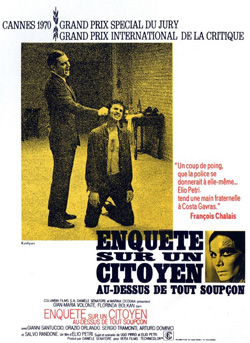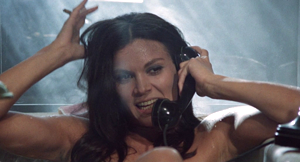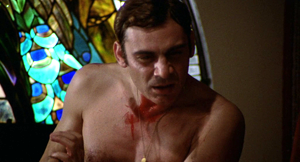
Aka Enquête sur un citoyen au-dessus de tout soupcon (Fr), Ermittlungen gegen einen über jeden Verdacht erhabenen Bürger (West Germany), Indagine su un cittadino al di sopra di ogni sospetto (It)
Italy
1970
Produced by Daniele Senatore & Marina Cicogna for Vera Film
Director: Elio Petri
Story & screenplay: Elio Petri, Ugo Pirro
Cinematography: Luigi Kuveiller
Music: Ennio Morricone, conducted by Bruno Nicolai
Editor: Ruggero Mastroianni
Art director: Carlo Egidi
Cameraman: Ubaldo Terzano
Release dates & running times: Italy (09/02/70), France (70, 95 mins), West Germany (13/11/70, 115 mins), US (70, 112 mins)
Filmed: Incir-De Paolis Studios (Rome)
Italian takings: 1.883.000.000 lire
Cast:Gian Maria Volonté (the ‘inspector’), Florinda Bolkan (Augusta Terzi), Gianni Santuccio (the judge), Orazio Orlando (‘Biglia’), Sergio Tramonti (Antonio Pace), Arturo Dominici (Mangani), Massimo Foschi (Terzi), Vittorio Duse (Canes), Aldo Rendine (Nicola Panunzio), Aleka Paizy (the ‘Inspector’s maid), Pino Patti, Giuseppe Licastro, Filippo De Gara (police interrogator), Fulvio Grimaldi (Paese Sera journalist), Ugo Adinolfi (an agitator), Gino Usai (an agitator), Franco Marletta, Giacomo Bellini, Giuseppe Terranova, Roberto Buonanni, Vincenzo Falanga (Pallottella) and with Salvo Randone (the plumber)
IMDB credits: Guido Buzzelli, Roberto Bonanni
For his next film, 1969’s Investigation of a Citizen above Suspicion, Petri turned his eye to the then nascent urban crime thriller, a genre that reflected – and some would say preyed upon – the political and economic uncertainties rife in Metropolitan Italy at the time. Many of those working in the area – Enzo Castellari and Umberto Lenzi, for instance – were happy to provide a roller-coaster ride of car chases, gun fights and assorted street scum having the bejesus beaten out of them. With this film, however, Petri joined a smaller and more thoughtful cadre of directors – most particularly Damiano Damiani and Carlo Lizzani – who found the developing narrative conventions of the genre to be rich ground for their trademark combination of populism and polemic.
He certainly hit a profitable seam: this became – by some distance – his biggest domestic box office success. It also won critical plaudits around the world, including an Oscar (for best foreign language film) and assorted awards at the Golden Globes and Cannes.

The plot revolves around ‘the inspector’ (Gian Maria Volonté), a police commissioner who’s just been promoted from his job in homicide to a new position as the ‘chief of political intelligence’. Which makes it very strange that he murders his girlfriend, Augusta (Florinda Bolkan), and makes sure to leave as many incriminating clues – fingerprints, footprints, a razor blade – in her apartment as possible. What’s his game? Well, he’s testing whether he has reached such a level in society that he has become, through the innate corruption of the system, ‘above suspicion’. And as the investigating officer – it’s his last case before moving on – it seems that he’s going to succeed.
The police blunder about hopelessly, their initial suspect being Augusta’s homosexual ex-husband (Massimo Foschi). The Inspector, however, has a different game in mind. Unwilling to allow an innocent man to be convicted, he diverts suspicion onto someone he feels to be guilty: a rather obnoxious anarchist, Antonio Pace (Sergio Tramonti), who also happened to be a lover of the dead woman’s. Nobody, of course, thinks that the Inspector could be the guilty party: his fingerprints are dismissed because he was in the apartment after the murder. He even goes so far as to confess his crime, but everybody he tells is reluctant (or afraid) to believe a policeman could be responsible.
Co-scripted by Ugo Pirro (7), this stands simultaneously as being both one of Petri’s most complex and one of his simplest works. The idiosyncratic narrative is fairly straightforward; a tightly constructed, albeit twisted, mystery that features little in the way of his trademark surrealistic asides (apart, perhaps, from the bizarre ending). Many of Petri’s films do feature a giallo element – from The Assassin through to Good News – but often this aspect sits way down in the mix.

Dig a little deeper, however, and a whole mass of themes become clear. The central character of ‘The Inspector’ – who remains unnamed throughout – is, in some ways, a typical protagonist for the director: a middle aged man going through a crisis and burdened by self doubt. Of course, he’s also very different in that he’s a power-crazed megalomaniac (a notional insanity shared with A Quiet Place in the Country’s Leonardo and Todo Modo’s Bishop Gaetano). Despite symbolizing the excesses of fascist-style ‘authority’, the character is also sympathetic in that the awful acts he commits have a dreadful kind of logic, so much so that he ends up as much a victim of his own machinations as anybody else.
Technically, Investigation of a Citizen above Suspicion is a very accomplished film. It features one of Morricone’s best soundtracks, smooth editing and some astonishing cinematography. The art direction is more restrained than in The Tenth Victim or A Quiet Place in the Country, but Augusta’s flat and wardrobe stand as a testament to excess. Most importantly, Volonté’s performance is astonishing: veering from coy to chummy, from pathetic to murderous, his ‘Inspector’ is one slippery character it’s quite impossible to get a proper hold of. Hardly ever off the screen, this was the film that muscled him into the position of torch-holder for the Italian left; a role he maintained with some aplomb throughout the 70s.
(7) Ugo Pirro had worked on many films in the early sixties prior to his involvement with Petri, and had forged a fruitful collaboration with Carlo Lizzani on films such as Attention! Bandits! (Achtung! Banditi!, 51), The Hunchback of Rome (Il gobo, 60) and Wake Up and Kill (Svegliati e uccidi, 66) before writing We Still Kill the Old Way. He went on to win plaudits for work such as The Garden of the Finzi-Continis (Il giardino dei Finzi-Continis, 70), but is probably most notable for fans of cult cinema as one of the key figures in the genesis of the Italian crime film, scripting key sixties films such as Mafia (Il giorno della civetta, 68) and Sardinia Kidnapped (Sequestro di persona, 68).